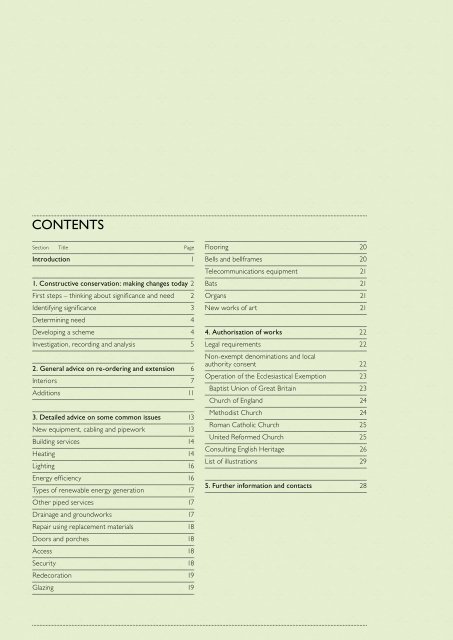NEW WORK IN HISTORIC PLACES OF WORSHIP - English Heritage
NEW WORK IN HISTORIC PLACES OF WORSHIP - English Heritage
NEW WORK IN HISTORIC PLACES OF WORSHIP - English Heritage
Create successful ePaper yourself
Turn your PDF publications into a flip-book with our unique Google optimized e-Paper software.
<strong>NEW</strong> <strong>WORK</strong> <strong>IN</strong> <strong>HISTORIC</strong> <strong>PLACES</strong> <strong>OF</strong> <strong>WORSHIP</strong><br />
1<br />
CONTENTS<br />
Section Title Page<br />
Introduction 1<br />
1. Constructive conservation: making changes today 2<br />
First steps – thinking about significance and need 2<br />
Identifying significance 3<br />
Determining need 4<br />
Developing a scheme 4<br />
Investigation, recording and analysis 5<br />
2. General advice on re-ordering and extension 6<br />
Interiors 7<br />
Additions 11<br />
3. Detailed advice on some common issues 13<br />
New equipment, cabling and pipework 13<br />
Building services 14<br />
Heating 14<br />
Lighting 16<br />
Energy efficiency 16<br />
Types of renewable energy generation 17<br />
Other piped services 17<br />
Drainage and groundworks 17<br />
Repair using replacement materials 18<br />
Doors and porches 18<br />
Access 18<br />
Security 18<br />
Redecoration 19<br />
Glazing 19<br />
Flooring 20<br />
Bells and bellframes 20<br />
Telecommunications equipment 21<br />
Bats 21<br />
Organs 21<br />
New works of art 21<br />
4. Authorisation of works 22<br />
Legal requirements 22<br />
Non-exempt denominations and local<br />
authority consent 22<br />
Operation of the Ecclesiastical Exemption 23<br />
Baptist Union of Great Britain 23<br />
Church of England 24<br />
Methodist Church 24<br />
Roman Catholic Church 25<br />
United Reformed Church 25<br />
Consulting <strong>English</strong> <strong>Heritage</strong> 26<br />
List of illustrations 29<br />
5. Further information and contacts 28<br />
<strong>IN</strong>TRODuCTION<br />
<strong>English</strong> <strong>Heritage</strong> believes that this country’s historic places of worship should retain their role as living<br />
buildings at the heart of their communities. We want to help congregations accommodate changes<br />
that are needed to achieve this, in ways which will sustain and enhance the special qualities of their<br />
buildings. Our formal role is to act as a consultee in the statutory processes for controlling works to<br />
listed places of worship, but we can also offer pre-application advice to congregations to help them<br />
develop proposals, based on our experience and expertise in working with the historic environment.<br />
Most historic places of worship retain a settled pattern<br />
of use, based around worship and mission, but often<br />
involving a range of events and activities, for the<br />
congregation or the wider community. <strong>English</strong> <strong>Heritage</strong><br />
supports the efforts of congregations to keep their<br />
places of worship in use wherever practical, mindful of<br />
the threat posed by closure to the special architectural<br />
and historic interest of the buildings. 1 We welcome<br />
proposals for appropriate additional uses and new<br />
facilities such as kitchens and toilets which will help to<br />
sustain these important parts of our heritage in use.<br />
Places of worship from earlier centuries have generally<br />
been altered or rearranged a number of times in their<br />
history to meet changing needs and the evidence of<br />
change is often part of our appreciation of them. The<br />
process of change has not, however, been a neutral<br />
one: alterations which were once acceptable may now<br />
be regrettable, while people may be content with<br />
certain changes today which in the past would not<br />
have been permitted. The need for consent to make<br />
alterations provides a means of managing change which<br />
recognises the importance of sustaining and enhancing<br />
the values of listed places of worship for this and future<br />
generations. We believe that successful schemes of<br />
new work come from a shared understanding of, and<br />
respect for, both the cultural significance of the building<br />
and the needs of its users.<br />
This guidance sets out the issues that <strong>English</strong> <strong>Heritage</strong><br />
believes need consideration when new work is being<br />
proposed for places of worship and indicates our<br />
general views on those issues. Not all factors will<br />
be relevant in all cases and the guidance needs to<br />
be applied proportionately, on a case-by-case basis,<br />
according to the significance of the historic interest and<br />
the extent and nature of the works proposed.<br />
GENERAL PR<strong>IN</strong>CIPLES<br />
<strong>English</strong> <strong>Heritage</strong> considers that new work in historic places of worship should:<br />
• be based on an understanding of the cultural and heritage significance of the building;<br />
• minimise harm to the special historic, archaeological, architectural and artistic interest of the<br />
building, its contents and setting;<br />
• bring with it public benefits, such as securing the long-term use of the building, which<br />
outweigh any harm to significance;<br />
• achieve high standards of design, craftsmanship and materials.<br />
1. See <strong>English</strong> <strong>Heritage</strong> (2010) New Uses for Former Places of Worship.

















